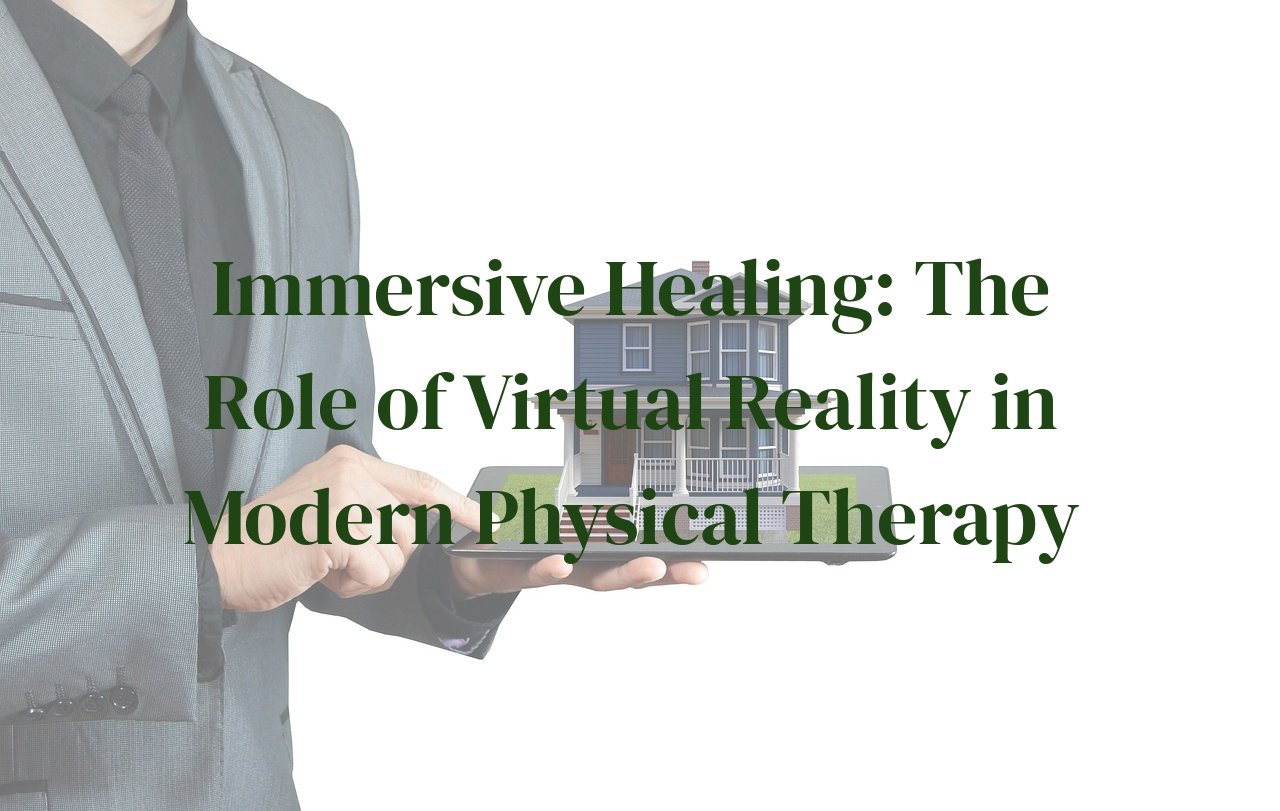
In this post, we’ll delve into the fascinating integration of Virtual Reality (VR) into Physical Therapy, uncovering its revolutionary potential beyond the gaming realm. You’ll learn specifics about how VR is being harnessed to aid physical rehabilitation, what scientific studies are saying, and firsthand experiences from therapists and patients.
If you’re curious about cutting-edge technology in healthcare or searching for innovative ways to enhance recovery, this post is your go-to guide. It will empower you with knowledge that can make a significant impact on your understanding of modern therapeutic techniques.
Table of Contents
The Evolution of Virtual Reality in Physical Therapy
Virtual Reality (VR) in physical therapy has undergone an extraordinary transformation. What was once considered a realm exclusive to gaming enthusiasts has now permeated the walls of clinical rehabilitation facilities, offering a novel approach to patient care. My journey in observing and researching this evolution has been nothing short of astonishing.
Initially, VR technology was rudimentary, with bulky headsets and limited interactivity. Early applications in physical therapy were simplistic, mostly involving guided imagery to relax patients. As a medical professional, I found these early stages somewhat underwhelming, though the potential was evident even then.
The development of more sophisticated hardware, like the Oculus Rift and HTC Vive, opened new possibilities. Suddenly, VR was not just about passive observation; patients could interact within virtual environments that mimicked real-world scenarios. In one of my clinical rotations, a patient recovering from a stroke used VR to relearn walking. The system simulated varied terrains, providing a controlled yet realistic setting for gait training. The improvement in their confidence and physical capabilities was remarkable.
With advancements in motion-capture technology, VR started to offer real-time feedback, essential for corrective exercises. Customized VR programs could now target specific rehabilitation needs. For instance, shoulder rehabilitation exercises, which can be monotonous, became engaging when transformed into an underwater treasure hunt game. This not only heightened patient compliance but also accelerated recovery rates.
Software innovation paralleled hardware advancements. Sophisticated algorithms now assess patient movements and adapt exercises. During a conference, I had the opportunity to interact with a VR system that personalizes rehabilitation activities based on a patient’s daily progress. Imagine the empowerment patients feel when their therapy sessions evolve in real-time to match their recovery trajectory!
Telemedicine integration was another pivotal milestone. VR platforms began to offer remote sessions, allowing therapists to reach patients beyond geographical barriers. This was particularly transformative during the COVID-19 pandemic. I witnessed firsthand how VR enabled uninterrupted care for my patients, many of whom found traditional in-person visits daunting during lockdowns. It was a game-changer for continuity of care.
Today, VR in physical therapy is no longer a futuristic concept but an integral part of modern practice. The ongoing merger of artificial intelligence with virtual reality promises even more personalized and effective rehabilitation protocols.
From my personal experience and the stories shared by fellow professionals, it’s clear that the journey of VR in physical therapy reflects a broader trend – the integration of cutting-edge technology to enrich human health and well-being. As we look to the future, this synergy between technology and therapy is bound to transcend the limitations of physical rehabilitation as we know it.
How VR Enhances Patient Recovery: Real-World Examples
One of the most exciting aspects of using Virtual Reality in Physical Therapy is its tangible impact on patient recovery. Take the case of stroke rehabilitation. Traditional methods often involve monotonous exercises that can be demotivating. However, with VR, these exercises are transformed into engaging, interactive experiences that captivate patients. For example, a patient recovering from a stroke can engage in a VR simulation where they navigate through a serene forest, reaching out to touch virtual objects which help improve limb coordination and fine motor skills.
In my personal experience, I encountered a patient with severe PTSD coupled with physical injuries. His progress was stunted by a constant fear of movement. Introducing VR as a part of his therapy helped immensely. The virtual environment allowed us to create controlled, safe scenarios where he could confront his fears without real-world repercussions. This significantly boosted his confidence and allowed for gradual physical movements that he had been reluctant to perform in a traditional therapy setting.
A compelling example comes from the use of VR for chronic pain management. Chronic pain patients often suffer from a significant reduction in quality of life. It was astonishing to see a patient, who had been bedridden for months, experience immediate pain relief upon donning a VR headset and immersing themselves in a tranquil beach environment. The power of distraction and the engagement of multiple senses played a vital role in altering their perception of pain.
I also recall working with a young athlete recovering from an ACL injury. Traditional exercises were too repetitive and did not engage her interest, leading to inconsistent attendance. By incorporating VR, we were able to simulate sports scenarios that were not only fun but also functional. This method saw her attend more sessions, perform better, and recover faster than expected. The gamified elements kept her motivated and competitive, making her rehabilitation less of a chore and more of a challenge she was eager to overcome.
Moreover, elderly patients with mobility issues have benefited from VR fall-prevention exercises. These digital simulations mimic real-world challenges like uneven ground or unexpected obstacles, helping them practice responses and improve their balance in a safe environment. Patients have reported feeling more secure and confident in their daily activities, directly attributing their progress to the virtual practice.
The adaptability of VR is also noteworthy. Customized programs can be developed to cater to the specific needs of each patient, whether they are dealing with neurological conditions, orthopedic injuries, or even cardiac rehabilitation. This personalization is a game-changer, allowing for targeted therapy that traditional methods simply cannot offer to the same extent.
Scientific Evidence and Studies Backing VR in Physical Therapy
Virtual Reality (VR) has blossomed from a niche technology into a scientifically-backed tool for enhancing physical therapy outcomes. Numerous studies have documented the efficacy of VR in rehabilitation, presenting compelling evidence for its integration in modern healthcare. One of the major studies, published in the Journal of NeuroEngineering and Rehabilitation, demonstrated significant improvements in motor function for stroke patients who participated in VR-based therapy compared to traditional methods.
Researchers conducted a randomized controlled trial involving stroke survivors, where one group underwent conventional therapy and the other engaged in VR sessions. The results showcased that the VR group experienced better balance, coordination, and fine motor skills. This is largely attributed to the immersive and engaging nature of VR exercises, which improve patient motivation and compliance.
An additional study from the American Journal of Physical Medicine & Rehabilitation evaluated the use of VR in managing chronic pain in patients with musculoskeletal issues. It revealed that VR therapy reduced pain perceptions and improved physical functioning significantly. The interactive nature of VR helps distract patients from pain, allowing for more vigorous and effective therapeutic exercises.
Furthermore, research published in the Archives of Physical Medicine and Rehabilitation reported positive outcomes for VR-based rehabilitation in patients with Parkinson’s Disease. The study highlighted enhanced gait patterns, increased stability, and reduced risk of falls due to repetitive, task-specific VR exercises tailored to address movement disorders prevalent in Parkinson’s patients.
Equally noteworthy, a meta-analysis of VR interventions published in Frontiers in Neurology concluded that Virtual Reality is effective across various rehabilitation scenarios, improving mobility, balance, and even cognitive functions. The analysis underscored that VR provides a multidimensional therapeutic experience, integrating visual, auditory, and proprioceptive feedback, which is crucial for comprehensive rehabilitation.
The common thread across these studies is the personalized nature of VR therapy. Tailored virtual environments can be designed to meet the specific needs of each patient, thereby maximizing therapeutic benefits. As a physical therapy enthusiast and an early adopter of VR, I have witnessed the incredible transformation in patient outcomes firsthand. One particular patient, struggling with post-operative recovery, made significant strides due to the engaging nature of VR exercises, which converted what would have been a monotonous process into an exciting journey of recovery.
The scientific community’s endorsement of VR in physical therapy highlights its potential to revolutionize rehabilitation. With ongoing advancements and increasing evidence, the question is not if, but when VR will become a staple in physical therapy clinics worldwide.
Challenges and Limitations in Using VR for Rehabilitation
While virtual reality (VR) holds immense promise for enhancing physical therapy, it is not without its pitfalls. One of the most glaring challenges is the high cost associated with VR hardware and software. It’s worth noting that not all healthcare facilities have the budget to invest in cutting-edge VR systems, which can run into tens of thousands of dollars.
Moreover, the learning curve for both patients and healthcare professionals can be steep. Not everyone is tech-savvy, and mastering VR technology often requires specific training. This could be a barrier, especially for smaller clinics or practitioners who may not have the resources or time to train their staff adequately.
An often overlooked but critical limitation is the issue of motion sickness. VR systems are designed to be immersive, but this can sometimes have a downside, such as causing nausea and dizziness in some users. This is a significant drawback, particularly for individuals who are already struggling with health issues.
Another concern is the variability in patient response. While some individuals may find VR to be motivating and engaging, others might find it overwhelming or unappealing. Personalizing VR experiences to cater to each patient’s unique needs and preferences is still a developing field.
The clinical effectiveness of VR in physical therapy also faces scrutiny. While numerous studies support its benefits, there is still a lack of large-scale, long-term research to definitively prove its efficacy across various types of injuries and conditions. This makes it difficult for clinicians to fully endorse VR without reservations.
Last but not least, technical issues can disrupt therapy sessions. VR systems are prone to glitches, lag, and other technical failures, which can be frustrating for patients and therapists alike. Regular maintenance and updates are necessary to keep the systems running smoothly, but these can also be time-consuming and expensive.
Future Perspectives: What’s Next for VR in Physical Therapy?
The future of Virtual Reality (VR) in physical therapy is a thrilling frontier marked by boundless possibilities and transformative innovations. As VR technology advances, we are likely to witness shifts in how physical therapy is administered, offering dynamic solutions to longstanding challenges in patient rehabilitation.
One exciting development on the horizon is enhanced personalized therapy. Currently, VR can tailor exercises to meet individual needs, but the future holds even deeper customization potential. With the integration of Artificial Intelligence (AI) and machine learning, VR systems will analyze patients’ progress and adapt in real time. Think of a therapist who evolves with each session, adjusting the complexity of activities to match your pace, while ensuring optimal engagement and motivation.
We also foresee significant advancements in remote rehabilitation. As we experienced during the pandemic, access to healthcare can be a critical issue. Future VR systems might provide comprehensive, at-home therapy solutions. Imagine patients with mobility issues receiving high-quality physical therapy sessions right in their living rooms, supervised remotely by therapists through VR interfaces. This would bridge the gap between healthcare providers and patients, making life-changing therapy more accessible.
Another intriguing avenue involves the symbiotic relationship between VR and wearable technology. Wearables can now track movements and biometrics in real time. If integrated with VR, these devices will not just measure but enhance the therapeutic process. For instance, sensors could provide instant feedback on your posture or movement efficiency, and the VR environment could adjust accordingly to ensure you are getting the most out of each exercise.
Imagine Virtual Reality systems with biofeedback capabilities. This means not only visual and auditory feedback but also haptic (touch) and even olfactory (smell) feedback to create an immersive environment that stimulates multiple senses simultaneously. These multi-sensory experiences could drastically reduce pain levels by diverting attention away from discomfort, encouraging patients to complete their sessions with less perceived strain.
My personal journey in exploring VR for physical therapy has revealed its profound potential for gamification of therapy exercises. Moving forward, we will likely see even more seamless blending of engaging gameplay elements with therapeutic goals. Future VR games won’t just be fun; they will be meticulously designed to target specific muscle groups, improve motor skills, and boost mental health—all while patients think they are just playing a game.
Further down the line, we might see VR systems that incorporate social aspects into physical therapy. Virtual support groups or multiplayer rehabilitation sessions could become standard, providing patients with a sense of community and shared purpose. This can be particularly beneficial for individuals facing long-term recovery, as peer support often leads to enhanced motivation and better outcomes.
Ultimately, the future of VR in physical therapy is a canvas yet to be fully painted. The intersection of advanced technology and compassionate care has the potential to not just improve physical outcomes but also enhance the overall patient experience. As we move forward, it’s vital to stay engaged with these advancements and advocate for their integration into mainstream healthcare, making advanced, personalized rehabilitation accessible to all who need it.
Conclusion
Virtual Reality is not just a tool for gamers anymore; it is shaping up to be a cornerstone in modern physical therapy. From improving patient engagement to offering personalized recovery plans, the potential is limitless. As this technology continues to develop, we can expect even more groundbreaking applications that will redefine therapeutic practices. The future of physical therapy is here, and it’s virtual.



